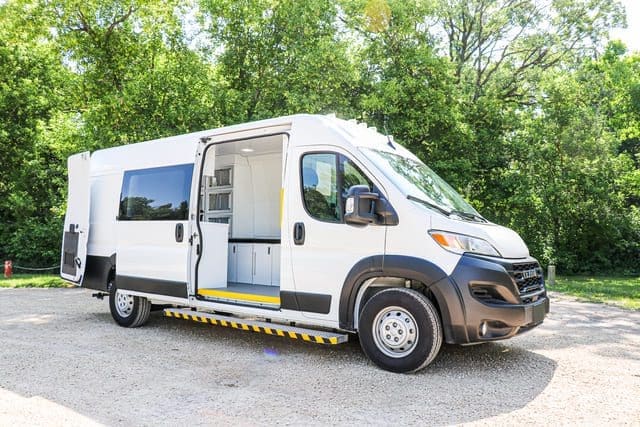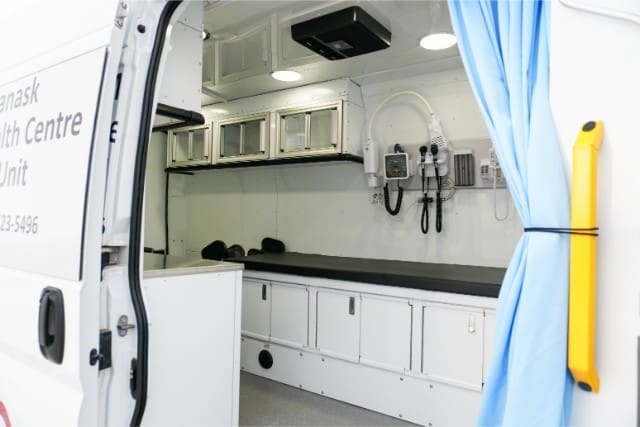Around every 3 minutes and 30 seconds, someone in the U.S. loses a limb because of diabetes-related complications like foot ulcers or infections. That’s not a typo. That’s the reality we’re facing. And if you’re running a healthcare organization, community program, or public health service, you already know the pressure.
- You’re trying to reach patients who are hard to reach
- You’ve seen the consequences of late care
- You’ve seen what happens when small foot issues turn into amputations
Some can’t drive, others live in rural areas, and many just don’t have the time, money, or support to make it to regular foot checkups. When diabetic foot care is delayed, the risks grow fast. What starts as a small sore can lead to infections, hospital stays, or even amputation.
Hi, I’m Russ Evans. I’m a mobile healthcare advocate with AVAN Mobility, and I work with teams just like yours and the Community Clinic of Southwest Missouri. I have a background in emergency response and try to keep people out of emergency rooms who don’t need to be there.
In this article, I’ll explain:
- What mobile podiatry is
- How it improves diabetes outcomes
Let’s dive in.
What is mobile podiatry?
Mobile podiatry is a service that involves foot care that comes to your patients. A mobile podiatrist visits people where they live or stay, like at home, in a care home, or at a community center. Patients don’t need to drive, find a ride, or wait in busy waiting rooms.
If you work with people who have diabetes, you know how fast a tiny foot problem can turn into something serious. A sore or blister can lead to an infection. That can lead to a hospital visit or even amputation. That’s why regular checkups are so important.
Mobile foot care usually includes:
- Foot exams: Checking for cuts, sores, or signs of nerve damage
- Wound care: Cleaning and covering small wounds to stop infection
- Nail care: Trimming thick nails and treating problems like fungus
- Skin care: Helping with dry or cracked skin
- Shoe tips: Helping people find better shoes that protect their feet
- Simple education: Teaching people how to care for their feet every day
If your organization supports older adults, a mobile podiatrist for elderly patients can catch small problems before they grow. And with regular mobile diabetic foot care, you can help people stay healthy and out of the ER.
Next, let’s look deeper at how mobile podiatry improves diabetes outcomes.
How does mobile podiatry improve diabetes care outcomes?

With my background in emergency care, I see way too many people go to the emergency room who don’t need to be there. All across the U.S., stretchers are rolling in with patients with foot infections, ulcers, or wounds that started as something minor.
A tiny cut. A sore they didn’t feel. A toenail that got infected. These are painful and dangerous. And in many cases, they didn’t need to end up in the ER.
This is where mobile podiatry can make a huge impact. It’s preventive care. It catches the little things early, before they grow into big problems. And for people living with diabetes, that’s life-changing.
When someone has diabetes, they may not feel pain in their feet the same way. Cuts and scrapes can go unnoticed. Healing takes longer, and infections can spread fast. Without regular checkups, what starts small can lead to emergency surgery or even amputation.
Mobile diabetic foot care helps prevent this. A mobile podiatrist visits patients where they are and checks their feet for signs of trouble. They clean and treat wounds, trim nails safely, and give people simple tips to care for their feet at home.
Here’s how this improves outcomes:
- Fewer emergency visits
- Lower risk of infections and amputations
- Faster treatment for small issues
- Better mobility and independence
- Stronger trust with regular care
If your organization works with older adults or people managing chronic health issues, mobile podiatry services can help prevent crises before they start. It’s a smarter, kinder way to care.
Who benefits from mobile podiatry services?
When I talk to organizations about mobile podiatry, the first thing I usually hear is, “Who exactly is this for?” The truth is, it helps more people than you might expect, but there are a few groups that benefit the most.
At the top of the list are older adults. Many of them have limited mobility, chronic health issues, or no easy way to get to a clinic. A mobile podiatrist for elderly patients helps them stay on top of foot care without needing to leave home. This kind of support can prevent falls, infections, and long recovery times that take a toll on quality of life.
Another big group is people living in rural or remote areas. Some communities don’t have a foot care clinic nearby. With mobile podiatry services, care travels to them, saving time, money, and stress.
We also see a big impact in low-income neighborhoods, shelters, and transitional housing programs. Transportation is often a barrier, as is taking time off work. A mobile podiatrist helps fill that gap by meeting people where they are without making them jump through hoops.
You’ll see the biggest impact in places where:
- Patients skip appointments due to a lack of transportation
- Chronic health conditions like diabetes are common
- Foot care is delayed until it becomes an emergency
- Families or staff are overwhelmed managing basic care
- Local clinics are stretched too thin or too far away
If your organization works with any of these types of people, mobile diabetic foot care can be one of the simplest ways to make a big difference fast.
What organizations can use mobile podiatry?
You don’t need to run a hospital to make mobile podiatry services part of your care model. In fact, some of the biggest wins I’ve seen have come from small, focused teams who simply saw a gap and decided to fill it.
If your organization already works with people who have diabetes, mobility challenges, or limited access to care, adding mobile foot care can strengthen what you’re already doing. You don’t have to build a new department. You just need a way to bring care to the people who need it most.
Here are some of the types of organizations offering mobile podiatry right now:
- Home healthcare providers: Adding foot care visits as part of routine checkups
- Public health units and FQHCs: Expanding services to underserved neighborhoods
- Tribal health programs: Reaching community members without nearby clinics
- Long-term care and assisted living centers: Keeping residents healthy and mobile
- Nonprofits and outreach teams: Supporting people in shelters or transitional housing
- Community paramedicine teams: Adding preventive care to follow-up visits
Your mobile podiatry setup can be as simple or advanced as you want it to be. Some use a fully outfitted mobile podiatry van. Others use a nurse or provider with a portable podiatry kit who travels between homes or facilities. Either way, it’s about closing the care gap on your terms.
If your team is looking for a cost-effective way to prevent serious complications, adding mobile diabetic foot care is a smart next step.
Interested in taking the next step with mobile podiatry?
You’re here because you’ve seen the gap. Patients with diabetes are slipping through the cracks. They’re missing basic foot care and ending up in the ER with problems that could have been caught early. That’s frustrating, not just for them, but for the teams trying their best to help.
Here’s what we covered:
- What mobile podiatry is and how it brings care to people where they are
- Who benefits most, from seniors to rural communities
- How it helps prevent infections, hospital visits, and amputations
- Which organizations are doing it, and doing it well
- What you need to get started, with simple, clear next steps
In my years in mobile healthcare, I’ve seen how fast minor problems grow when care is out of reach. That’s why I believe in this work. At AVAN Mobility, I help organizations like yours create real solutions that bring care closer to those who need it. We build mobile medical units with purpose, backed by experience, and driven by a mission to make healthcare easier to reach.
If you have questions or are ready to explore mobile podiatry options, click the button below to talk to a mobility expert who is ready to help.
If you’re not quite ready yet, we have a few other resources you might want to check out to keep learning.
Start off by checking out our article on mobile medical vans vs. RVs. This should help you determine which vehicle will work better for your program.
After that, read our article on mobile medical van customization. It’ll give you a closer look at some of the customization options you can include.





